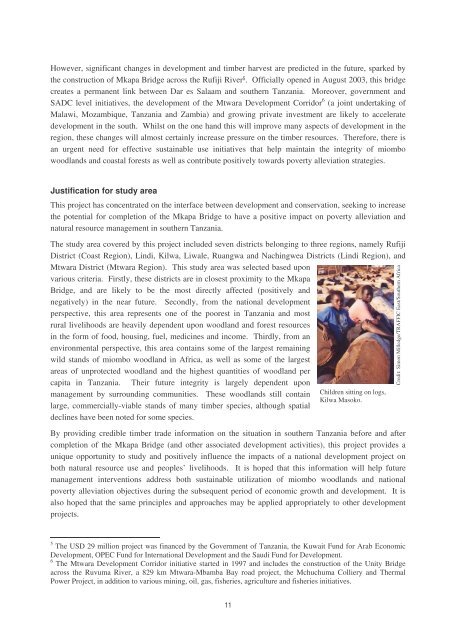Bridging the Gap: linking timber trade with infrastructural ...
Bridging the Gap: linking timber trade with infrastructural ...
Bridging the Gap: linking timber trade with infrastructural ...
You also want an ePaper? Increase the reach of your titles
YUMPU automatically turns print PDFs into web optimized ePapers that Google loves.
However, significant changes in development and <strong>timber</strong> harvest are predicted in <strong>the</strong> future, sparked by<br />
<strong>the</strong> construction of Mkapa Bridge across <strong>the</strong> Rufiji River 5 . Officially opened in August 2003, this bridge<br />
creates a permanent link between Dar es Salaam and sou<strong>the</strong>rn Tanzania. Moreover, government and<br />
SADC level initiatives, <strong>the</strong> development of <strong>the</strong> Mtwara Development Corridor 6 (a joint undertaking of<br />
Malawi, Mozambique, Tanzania and Zambia) and growing private investment are likely to accelerate<br />
development in <strong>the</strong> south. Whilst on <strong>the</strong> one hand this will improve many aspects of development in <strong>the</strong><br />
region, <strong>the</strong>se changes will almost certainly increase pressure on <strong>the</strong> <strong>timber</strong> resources. Therefore, <strong>the</strong>re is<br />
an urgent need for effective sustainable use initiatives that help maintain <strong>the</strong> integrity of miombo<br />
woodlands and coastal forests as well as contribute positively towards poverty alleviation strategies.<br />
Justification for study area<br />
This project has concentrated on <strong>the</strong> interface between development and conservation, seeking to increase<br />
<strong>the</strong> potential for completion of <strong>the</strong> Mkapa Bridge to have a positive impact on poverty alleviation and<br />
natural resource management in sou<strong>the</strong>rn Tanzania.<br />
The study area covered by this project included seven districts belonging to three regions, namely Rufiji<br />
District (Coast Region), Lindi, Kilwa, Liwale, Ruangwa and Nachingwea Districts (Lindi Region), and<br />
Mtwara District (Mtwara Region). This study area was selected based upon<br />
various criteria. Firstly, <strong>the</strong>se districts are in closest proximity to <strong>the</strong> Mkapa<br />
Bridge, and are likely to be <strong>the</strong> most directly affected (positively and<br />
negatively) in <strong>the</strong> near future. Secondly, from <strong>the</strong> national development<br />
perspective, this area represents one of <strong>the</strong> poorest in Tanzania and most<br />
rural livelihoods are heavily dependent upon woodland and forest resources<br />
in <strong>the</strong> form of food, housing, fuel, medicines and income. Thirdly, from an<br />
environmental perspective, this area contains some of <strong>the</strong> largest remaining<br />
wild stands of miombo woodland in Africa, as well as some of <strong>the</strong> largest<br />
areas of unprotected woodland and <strong>the</strong> highest quantities of woodland per<br />
capita in Tanzania. Their future integrity is largely dependent upon<br />
management by surrounding communities. These woodlands still contain<br />
large, commercially-viable stands of many <strong>timber</strong> species, although spatial<br />
declines have been noted for some species.<br />
Children sitting on logs,<br />
Kilwa Masoko.<br />
By providing credible <strong>timber</strong> <strong>trade</strong> information on <strong>the</strong> situation in sou<strong>the</strong>rn Tanzania before and after<br />
completion of <strong>the</strong> Mkapa Bridge (and o<strong>the</strong>r associated development activities), this project provides a<br />
unique opportunity to study and positively influence <strong>the</strong> impacts of a national development project on<br />
both natural resource use and peoples’ livelihoods. It is hoped that this information will help future<br />
management interventions address both sustainable utilization of miombo woodlands and national<br />
poverty alleviation objectives during <strong>the</strong> subsequent period of economic growth and development. It is<br />
also hoped that <strong>the</strong> same principles and approaches may be applied appropriately to o<strong>the</strong>r development<br />
projects.<br />
Credit: Simon Milledge/TRAFFIC East/Sou<strong>the</strong>rn Africa<br />
5 The USD 29 million project was financed by <strong>the</strong> Government of Tanzania, <strong>the</strong> Kuwait Fund for Arab Economic<br />
Development, OPEC Fund for International Development and <strong>the</strong> Saudi Fund for Development.<br />
6 The Mtwara Development Corridor initiative started in 1997 and includes <strong>the</strong> construction of <strong>the</strong> Unity Bridge<br />
across <strong>the</strong> Ruvuma River, a 829 km Mtwara-Mbamba Bay road project, <strong>the</strong> Mchuchuma Colliery and Thermal<br />
Power Project, in addition to various mining, oil, gas, fisheries, agriculture and fisheries initiatives.<br />
11
















